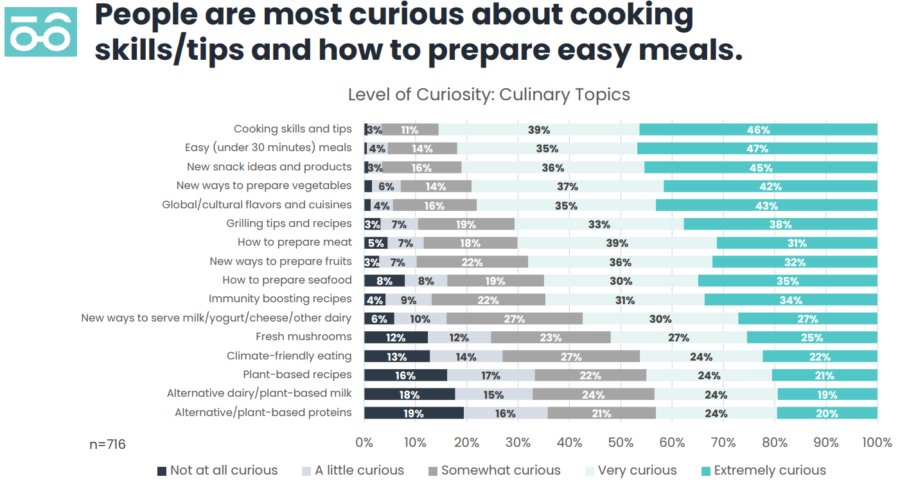I’m excited about “simple” foods like ramen and creating “hacks” that elevate them.
I’m curious about quick and easy recipes.
Lately I’ve been learning how slightly burnt things add a lot of flavor.
Curiouser and curiouser! Those are just a few of the 700+ respondents’ comments from the Consumer Curiosity Report from Minneapolis-based consulting agency Curious Plot, which serves clients in the food, agriculture, and companion animal care markets.
“We often talk about the value of curiosity,” said Amy Wood, senior vice president and strategist at Curious Plot, in a recent chat with The Food Institute.
“We’re innately curious about consumers and want to know as much as we can about their food interests. Most consumer studies measure consumer interests that have already matured, so we decided to instead measure curiosity because we want to spot and nurture trends that are still developing.”
Wood said the challenge of a study like this is outlining the themes people may be curious about. “We developed a solid list of current and emerging food themes to measure in our inaugural year,” she added. “We started as broadly as possible to establish baseline data on the themes we believe will be critical to track for years to come. We’ll continue to add new themes in future years.”
Wood said food trends are driven by early food adopters who significantly influence mainstream consumers.
“Measuring the curiosity of early food adopters gives us a head start to understanding and nurturing future food trends – these consumers are leading the way. If they’re curious about foods with cognitive health benefits, for example, we can anticipate that mainstream consumers will share that curiosity before long.”
With the genesis of the Curiosity Report in place, here’s what Wood and the Curious Plot team landed upon:
The goal: to gauge consumer interest on culinary, nutrition, and sustainability topics.
The respondents: a cherry-picked, quantitative survey of verified early food adopters, which the report classifies as those interested in eating out at restaurants and/or food and drink festivals; those who interact with food/drink online content at least once per week; and those who consider trying new foods and flavors to be important.
The results: Food companies and brands that can zero in on the Venn diagram between swift meals and snacks, functional foods that improve gut health and promote cognition, and do so in an eco-friendly package that reduces food waste, will find consumers eager for their products.
The report laid bare one simple fact (and titled one slide as such): there is no shortage of consumer curiosity. Of the three categories, here are top three responses from the early food adopters about what they look for in their own lives regarding the culinary aspects of food and drink; how they view products that affect their nutrition (and purport to help improve it); and how sustainability and ESG initiatives play into how and why they choose to spend their money.
The top three subcategories within each segment are as follows:
- Culinary Topics: Cooking skills & tips; Easy (under-30-minute meals); New snack ideas & products
- Nutrition Topics: Foods that improve gut health; Foods with cognitive health benefits; Benefits of eating more fruits & vegetables
- Sustainability Topics: Reducing food waste; Animal welfare; Farm worker welfare
Curiosity About Culinary
“What’s exciting for us are the simple things consumers are curious about; those simple things are still of interest,” Wood said, noting basic cooking skills and tips, which was the No. 1 answer in the Culinary section of the report, edging easy (under-30-minute meals) by a hair.
Eighty-five percent of respondents chose it as one of their top categories, helping explain the grocery and retail growth of swift meals driven by convenience and often associated with nostalgia; as consumers enter their 20s and start budgeting for living as adults, wielding basic kitchen skills goes a long way toward a happy, healthy, proactive life in the food sphere, enabling at-home chefs to stretch their skills or simply allowing busy consumers to whip up a swift meal and move on with their days, their evenings, their jobs, and their lives.
Wood also mentioned “off-the-charts curiosity” about global flavors, further cementing scads of industry data about how flavor profiles and palates of the American consumer are trending toward the bold, the spicy, and the novel, both at home and in retail, grocery, and restaurant dining.
“That’s something we can always lean into as marketers to help consumers explore their palates,” Wood mentioned. And in many ways, the world around them.

courtesy Curiosity Plot
Novel Nutrition Newcomers
Cristie Mather is vice president of food at Curious Plot, and she observed that, “Given that flavor and usage almost always come out on top in consumer surveys, we were surprised to see culinary came out on top, followed by nutrition and sustainability.”
Of particular note was how predominantly meat eaters (or at least those with no plans to change their meat-forward lifestyles) squared up with the vegetarian/pescatarian crowd; like many binaries in American culture, both sides expressed similar goals and simply had different ways of getting there, noting that three of the top five trends for both groups were the exact same: burgeoning interest in global and cultural flavors; concern for animal welfare; and finally, foods that improve gut health, which red meat is not really celebrated to do.
“What really stood out to us was the level of curiosity about functional nutrition,” Wood added. “Foods with cognitive health benefits and foods that improve gut health stood out.”
“It’s fascinating to see the similarities of top-ranked curiosities between both lifestyles,” Mather said, lending credence to the idea that if you want to get to know someone, share or (even better) cook a meal with them. When people are given a mundane task and nowhere to go, ideas—like oil in a warming pan—can start to sizzle, adding flavor and nuance to the entire experience.
The commodification and snackification of fruits and vegetables also received top billing from respondents in the culinary department: Almost 80% were very or extremely curious about new ways to prepare vegetables, while 68% felt the same about preparing fruits, especially amid the heyday of the frozen retail aisle. And eight in 10 stressed new snack ideas were top-of-mind as well.
In Service to Sustainability
One of the more surprising aspects of the entire report was the top category in sustainability: reducing food waste, besting both animal welfare and (equally surprising) farm worker welfare, a topic not nearly as discussed around the kitchen table as the two categories above it.
Sustainable packaging, on the other hand, didn’t crack the top three, indicating a marketing or perhaps perception disconnect from differentiating food waste with packaging waste; for many eco-conscious companies and brands, they’re often one and the same.
“In the consumer reason mindset right now, there’s so much focus on the cost of food and inflation and how it impacts buying decisions,” Wood said to The Food Institute. “It’s absolutely an economic situation; consumers don’t want to waste anything.
“The second aspect of food waste is it’s something consumers have a personal stake in. Many aspects of food sustainability are in the hands of producers or brands, but consumers can have an influence in reducing their own food waste—that’s something that’s attainable and in their control. Food marketers can lean into this curiosity by giving consumers ideas to reduce food waste. For example, the Watermelon Board does this nicely with their ‘Use the Whole Watermelon’ messaging, teaching consumers how to cut and store watermelon and even use the rind.”
Putting It All Together
The Consumer Curiosity Report was the first inaugural report developed by the team at Curious Plot to not only learn how food-forward consumers think and behave, but to help establish, foster, and share new food trends from home to aisle, retail to restaurant.
Final analysis of the data—at least at this early juncture—proffered two questions to the food/bev space:
- How can brands deliver an easy, inspiring sense of culinary exploration?
- How can brands nurture and leverage consumer curiosities?
If companies can deliver the triple-threat knockout punch of nutritional value, culinary intrigue through flavor and texture, and deliver an eco-conscious experience, they’ll capture consumers out at the cresting wave of new food trends, self-sustaining customer loyalty, and cutting-edge food tech via creative packaging with something equally novel, nutritious, and values-affirming within.
“The report you’re seeing only scratches the surface with the data we have; we’re intentionally withholding data and will be releasing three separate reports in a rolling fashion. For example, in the nutrition category, gut health and cognitive benefits were popular. But we want to share a deeper dive on that, asking how does that change by age? By location? How do those curiosities change by gender? Are those findings the same for those who eat meat or who don’t eat meat?”
Now more than ever, consumers want to celebrate their identities through the brands they support and cherish. Through food, you might say, we celebrate ourselves, and Curious Plot hopes to offer further insight in the months to come.












